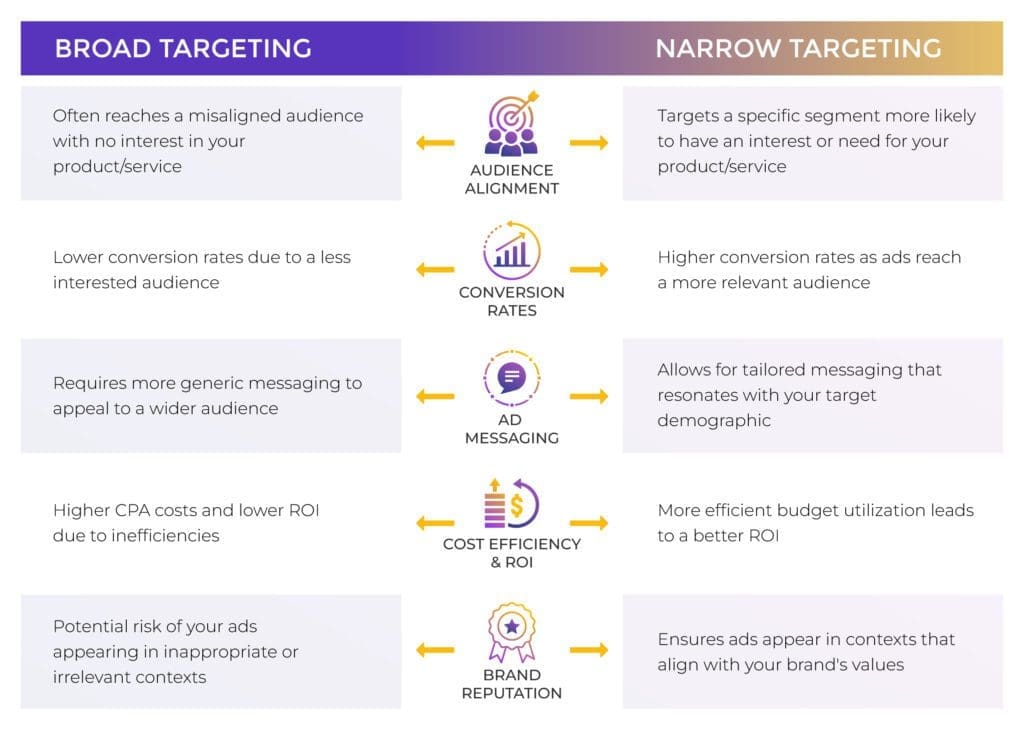Here’s why most ad networks’ promises are overblown and misleading
Ad networks,, often make big promises. They lure advertisers with talk of exceptional reach, narrow targeting, and high ROI on their dollars. But Ad networks aren’t flawless. Algorithm changes, policy updates, and shifting user behaviors can alter the landscape and impact you as an advertiser.
Table of Contents
It’s essential to approach these platforms with a strategic mindset, understanding that success involves continuous testing, adaptation, and a critical eye on campaign performance. But most importantly with a clear understanding of attribution settings and distribution of the ads and apps your adnetwork uses or even owns.
While ad networks offer incredible advertising tools, you must learn about this dynamic environment that ultimately determines your success.
Check out our article below on how Ad networks use exaggerated claims to sell themselves as a premium provider in the marketplace.
Common Ad Networks Promises
Let’s talk about the elephant in the room: the massive promises of ad networks. The industry’s countless claims of boundless reach, bullseye targeting, and sky-high ROI are everywhere as they are suspicious.
A report from Red Point Global revealed that 70% of advertisers expressed dissatisfaction with the lack of transparency in ad network operations.
Let’s unpack the puffery and get into the details.
The reach that overreaches
Ad networks will sell you the dream of omnipresent campaigns, boasting access to billions of impressions. Yet, what does that reach mean if it’s not reaching the right people, especially if those people are not real?
Juniper Research reported that ad fraud would cost marketers $84 billion in 2023, reflecting inefficiencies and lack of quality in ad targeting. The advertising industry has been under scrutiny for some of these practices, so as an advertiser you need to be fully aware.
Moreover, there are significant concerns about data security and privacy, suggesting that the targeting might not be as precise as advertised by networks.
Targeting: The Promise vs. The Performance
You’ve heard the spiel about how sophisticated targeting algorithms can deliver your ads to the perfect audience. However, analytics tell a different story.
For instance, conversion rates, which are a critical measure of the success of targeted campaigns, vary widely across industries such as fashion and finance to real estate and more, with the average conversion rate across all industries being 7.04% in 2023. This conversion rate is sourced from PPC platforms like Meta, Google, Snapchat, TikTok, and Bing.

This indicates that the majority of traffic generated from advertising does not convert, which is a failure to meet your targeting KPIs. Be careful of networks promising crazy conversion rates that typically fall outside your industry average.
Question the cost-effectiveness of your campaigns as well. A low CPC doesn’t necessarily translate into high-quality traffic or engagement with the site or app, which suggests that a significant proportion of your ad campaigns do not meet the desired level of audience engagement or conversion.
Publishers or networks promoting low CPC placements are probably selling cheap ad space that rarely converts. It’s time we question the ‘precision’ that these networks advertise.
As an advertiser you should always try to put your feet into the shoes of a publisher and ask yourself how a publisher could still make money when CPMs or CPCs are super low – what could be reasons for such discounts? Ads that users can’t click away? Impressions mimicking clicks? Ads being loaded in the background without being seen by a real user? There are plenty of reasons that could explain super high or super low conversion rates & prices. And let me tell you, most of the reasons are not good for you as the advertiser.
Focusing purely on ROAS can cost you big bucks
Ad networks also often gloat about high ROAS or ROI returns, but the devil is in the details. A high ROAS doesn’t necessarily mean your business is thriving. For example, this metric doesn’t account for the volume of sales, conversions, etc. A campaign could show a ROAS of 500%, but if it only led to a handful of transactions, is it truly a success for your business?
Ad Networks love to show how much return they can get for their clients, but what data are they collecting? Question high return claims, they are usually not achievable.
Moreover, a singular focus on ROAS can lead to a dangerous oversight of the overall volume of conversions. A strategy optimized solely for ROAS might reduce ad spending to maintain a high ratio, inadvertently sacrificing potential growth and market share. Check if the network is maybe stealing attributions & with this the precious conversions from another ad network or organics. Keyword: incrementality.
An impressive ROAS can also reflect short-term gains that may not translate into long-term customer value. For instance, a customer’s lifetime value and the cost to acquire a customer are pivotal metrics that ROAS doesn’t capture.
A profitable marketing strategy nurtures customer relationships over time, potentially leading to repeat sales and referrals, which is something ROAS doesn’t necessarily reflect.
We urge you to demand transparency from ad networks. Ask for detailed breakdowns of how ROAS is calculated and insist on understanding the broader picture of campaign performance, including metrics like LTV.
Here is a list of questions, you can ask:
- How Is ROAS being calculated in our campaigns?
- What metrics are included in your ROAS Calculation?
- Can you provide a performance breakdown across similar advertisers’ campaigns?
- How are you tracking conversions?
- How does seasonality affect our ROAS in campaigns?
Remember, a sustainable strategy focuses on long-term customer relationships and total revenue growth, not just the promises of high ROAS numbers.
Broad Targeting: A Mirage?

Broad targeting is just like the old adage of casting a wide net in the ocean and trying to catch a specific fish. Unskilled advertisers think that this assumption increases the likelihood of reaching the right people. However, this often leads to significant inefficiencies and a ton of wasted ad spend.
It’s important to consider a strategy that is more impactful in driving results such as narrow targeting. This method involves using data to identify and reach a specific audience segment more likely to be interested in your product or service rather than reaching out to everyone.
The goal of narrow targeting is to tailor your product or service to meet the specific needs and preferences of a selected segment of consumers instead of reaching a wider audience with multiple interests.
To help you understand the impact of targeting strategies on your ad campaigns, we put together a comparison table contrasting the effects of broad targeting vs. narrow targeting.

What about the impact on Brand Reputation?
A misstep in targeting can place your ads in contexts that don’t align with your brand’s values, potentially harming your reputation. Effective marketing and advertising are key to building and maintaining a positive brand image.
Imagine working with a network you never heard of, just to discover your ads are being broadly targeted on adult websites. This can severely hurt your trust in the space along with your potential customers. Don’t fall into the temptation of ad networks promising you millions of impressions from multiple sources, it never works.
It’s crucial to manage your online presence carefully, as every digital interaction shapes public perception of your brand.
The cost implications for large budgets:
Having a large advertising budget can be very costly if you don’t know how to properly allocate it. While it allows for a wider reach, broad targeting can lead to a significant waste of resources if not handled carefully. A substantial portion of your budget could be spent on reaching audiences with little to no interest in your offerings, thereby reducing your ROI.
Take PURE Dating for example, our case study highlighted an effective and cost-efficient strategy to help lower their CPI goals and surpassed their D7 ROAS all without breaking the bank.
Here’s our advice to you:
Start small and targeted. This allows you to test and refine your campaigns in a more controlled environment without letting your ads run wild. Broad targeting gives you a bad read on following the right KPIs that work for your campaigns. Ad Networks, like Google, love pushing broad targeting because it continuously has you throwing darts at board to see what eventually sticks, all while happily taking your budget.
 “It’s not just about casting the widest net, it’s about casting the smartest one.”
“It’s not just about casting the widest net, it’s about casting the smartest one.”
– Pablo Perez Gonzalez – Performance Marketing Director @ Admiral Media
While broad targeting might seem tempting due to its apparent simplicity and reach, its implications on brand reputation and cost efficiency make it less desirable.
Focusing on precise targeting ensures that your campaigns are both effective and a true reflection of your brand’s values. This definitely ensures that your ad spend is effective and reduces the risk of associating your brand with irrelevant or inappropriate content as well.
Transparency in Ad Networks
The need for transparency in ad networks is crucial for advertisers to make informed decisions and optimize their campaigns. Ad networks are often criticized for a lack of clarity in several key areas.
When things aren’t transparent, it can cause a lot of problems like inefficiency, money poured into ads without results, and a gap of trust.
Let’s explore how transparency can shape the future of ad networks and its importance.
Demanding transparency in Ad Network reporting
Many ad networks, outside of Google and Facebook, may not provide the level of transparency you might expect. This issue becomes especially clear when looking at how ad networks handle reporting metrics and the details of ad placements.
For example, Google App Campaigns (GAC) offer less granular insights primarily due to their high level of automation and reliance on machine learning. This simplifies campaign management but limits the depth of data that can be provided to you.
Another primary concern is the restricted control over ad placements. In GAC, the ability to specify target audiences, devices, or specific ad placements is limited due to its automated nature. This can be a significant constraint if your campaign strategy involves highly narrow targeting.
The automation in GAC offers limited opportunities for manual campaign adjustments. This can be challenging if you prefer a more hands-on approach to campaign management.
The reporting functions in GAC present its own set of problems as well. Detailed reports on the specific ad combinations viewed by users should be provided, which can limit your ability to analyze and understand the performance of individual ads. GAC also use of store text and other assets, often without explicit disclosure to you, introduces an additional layer of unpredictability in analyzing ad performance.
This lack of transparency in how ad content is curated and presented can lead to situations where your ads shown to users might not accurately represent your brand or could even potentially convey a message that conflicts with your brand values.
Mastering Your Campaign Insights
It’s crucial to have your own attribution platform to get an accurate read on your campaign performance, rather than relying solely on the data from ad networks.
Depending only on ad networks for performance metrics can sometimes lead to skewed or incomplete information, as these networks may focus on aspects that show their services in the best light.
With an independent attribution platform, you get an unbiased view of how effective your campaigns are. Campaigns often run across multiple channels, so it’s vital to have a tool that brings together and analyzes data from all these sources.
A separate platform offers this perspective, helping you understand the contribution of each channel to your marketing objectives and guiding smarter budget allocation.
Customization is another big plus of having your own system. You can have your tracking set up to specific metrics that you know drive a return, providing deeper insights than what you might get from standard ad network reports.
Such platforms are also invaluable for spotting discrepancies and potential fraud, ensuring the traffic and engagement your campaigns attract are real. Think of it as a form of insurance when testing out new ad networks, a way to verify their claims against actual results.
Think about investing in a separate attribution platform to gain the clarity and detail needed for data driven decision-making in your marketing campaigns. It ensures that every one of your advertising dollars is fully optimized, leading to better ROI and more successful marketing.
Wrapping Up
Misleading promises of ad networks are becoming standard in the industry, while every network chases for your dollar. You must approach these platforms with a strategic mindset to not get caught up in the fluff. While a few ad networks offer powerful tools for reach and targeting, others are not easy to spot.
As an advertiser, you should demand clarity and honesty from ad networks regarding their practices and performance metrics. Transparency within ad networks cannot be overstated especially given the significant concerns around ad fraud and data security. Remember, a sustainable advertising strategy focuses on long-term results and real customer engagement, rather than just impressive but potentially misleading metrics.
If you have any questions or need further insights into avoiding these types of networks, reach out to us here for expert guidance and support around these topics.

 “It’s not just about casting the widest net, it’s about casting the smartest one.”
“It’s not just about casting the widest net, it’s about casting the smartest one.” 



